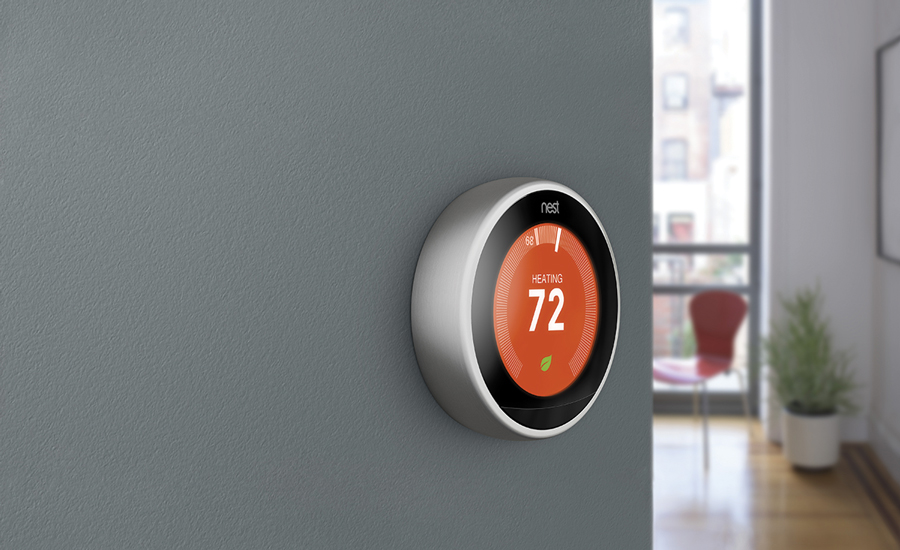For HVAC contractors, the thermostat market offers a great opportunity for growth.
A major manufacturer recently conducted a survey of 2,000 consumers asking for their feedback on smart products. When asked about their interest in purchasing smart products, more than 60 percent of respondents said they were interested in purchasing an intelligent control for their home. Other industry data shows that actual smart home product penetration is less than 20 percent.
That information shows there is a broad desire in smart home devices but somewhat limited participation. In the recent past, there might have been an assumption that millennials would make up the majority of those who want a smart thermostat. In 2017, that might not be the case.
“The data we’ve seen shows that Generation X’ers, baby boomers, and other generations all play a role,” said Gene LaNois, head of professional channel at Nest Labs. “They all may have different motives for buying the product — energy savings, style, convenience, ability to access a second home, etc. — but the great news for the industry is that this shows that the general masses are actively buying smart thermostats.”
In fact, 2016 was the year when connected thermostats started to edge out non-connected units on a dollar basis.
“In our view of the world, almost everyone is now a potential customer for connected thermostats. Like with any new technology, there are people who are going to be early adopters and those who adopt later on,” said A.J. Smith, vice president and general manager for E&ES Homes Americas at Honeywell Intl. Inc. “Our research indicates more than half of the U.S. population already has an interest in connected thermostats. We tend to look at the world more through people’s attitudes than demographics, so our biggest targets are families looking to make life a little simpler, and people who want to make sure their loved ones and homes are comfortable, safe, and secure.”
GROWING INTEREST
There are multiple reasons homeowners should be interested in new thermostats. Smartphones are now in the pockets of more than 80 percent of U.S. citizens, and being able to use an app to manage your comfort away from home or anywhere inside your home is a very powerful story. Second, the energy savings that people find with these devices is another attribute that seems to resonate.
Finally, there is an excitement associated with the connected home. Products that allow homeowners to control their thermostats through Amazon Echo, Google Home, or Apple HomeKit are a draw. They excite homeowners.
“We’ve found that many consumers are aware of the growing smart home and smart thermostat product offerings,” said Rob Munin, president and CEO, Lux Products Corp. “However, we have also found many HVAC professionals playing catch-up to consumers in this category. HVAC professionals have a real opportunity by partnering with manufacturers and distributors to become experts. Consumers are looking for experts to help them select the right products for their homes, and HVAC professionals need to embrace this opportunity.”
CONTRACTOR INSTALLATION
HVAC contractors tend to remain loyal to thermostats that are trouble-free, for obvious reasons. After all, if the thermostat doesn’t work properly, blame is often assigned to the contractor who installed the “faulty system,” and this can lead to costly call-backs to fix the problem.
“Avoiding callback and quality issues is important to our bottom line,” said Lane Ladewig, vice president of construction at Pearson Mechanical in Arlington, Texas. “If we repeatedly return for callbacks, we lose money. That happens with some thermostats — we have had a lot of them go out on us in a relatively short amount of time.”
According to Glenn Moore, president and CEO of Braeburn Systems, the most reliable thermostats in the industry meet specifications, such as those outlined by the National Electrical Manufacturer’s Association (NEMA) Energy Aware® program, which outlines minimum quality standards for the construction, testing, and performance of thermostats.
“The last thing a contractor wants is to send a truck and crew for a $200 callback to repair something that should have been done right the first time,” said Moore. “If the thermostat fails, customers blame the contractor. So, the thermostat has to work properly the first time, every time.”
And, of course, price factors into the equation, but manufacturers believe homeowners may be willing to pay that higher price point.
“There will always be a threshold when it comes to pricing. In fact, when the Nest thermostat first came out, the traditional industry didn’t think it was going to be possible to have success with a thermostat priced at more than $200. At the end of the day, it comes down to how important energy savings, comfort, and style are to a person,” LaNois said.
“That said, the price points should begin to create a separation between a thermostat that is connected versus learning,” he added. “Having devices that are learning provides a much faster return on investment and will cost more up-front.”
Most manufacturers offer a range of products and price points for consumers to pick from.
“The particular connected thermostat, and what they are willing to pay for it, depends very much on the individual,” Smith said. “This is why we offer a range of smart, connected thermostats to provide the right offering to each segment. We have our top-of-the-line Lyric Round for those who want all the features and great design, but we also have our new T Series platform with multiple options for different consumer needs. The T Series models also have features that help our contractors complete the installation and setup quickly for homeowners who don’t want to do it themselves. This results in a great in-home experience with Honeywell technology and quality at a great price.”
Publication date: 6/12/2017
Want more HVAC industry news and information? Join The NEWS on Facebook, Twitter, and LinkedIn today!







